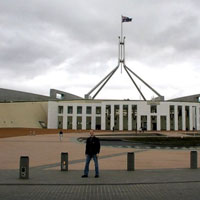- About Us
- Columns
- Letters
- Cartoons
- The Udder Limits
- Archives
- Ezy Reading Archive
- 2024 Cud Archives
- 2023 Cud Archives
- 2022 Cud Archives
- 2021 Cud Archives
- 2020 Cud Archives
- 2015-2019
- 2010-2014
- 2004-2009
 |
Australia Drops The Ball |
The Australian economy hits its fourteenth consecutive year of expansion this year, having avoided, among other potential recession-creators in that period, the impact of both the Asian currency crisis of 1997 and the tech boom fallout post-2000. And one could imply from the daily records being set by the All Ords that the country's economic future is also bright. But things are not as rosy as they seem. Particularly, there is reason to be concerned about Australia's future productive capacity.
 By the end of 2004 Australian GDP (the measure of the level of production) growth had slowed to only 1.5%, versus 3-4% in prior years, but our spending was still up at 4%. National accounts arithmetic tells us that the difference is our net export drain, approximately 2.5% in 2004. We have been importing heaps and not exporting enough, and this has been going on for years. Adding together balance of trade deficits with recurring negative income items (such as paying away interest and dividends to overseas investors) gives you a very big current account deficit, currently of the order of 7% of GDP.
By the end of 2004 Australian GDP (the measure of the level of production) growth had slowed to only 1.5%, versus 3-4% in prior years, but our spending was still up at 4%. National accounts arithmetic tells us that the difference is our net export drain, approximately 2.5% in 2004. We have been importing heaps and not exporting enough, and this has been going on for years. Adding together balance of trade deficits with recurring negative income items (such as paying away interest and dividends to overseas investors) gives you a very big current account deficit, currently of the order of 7% of GDP.
We fund this big deficit by borrowing from overseas, largely by issuing lots of bonds to offshore investors who love buying them because the yield is comparatively high and who in the last few years have had the additional lure of an appreciating Australian dollar. This 7% deficit number is actually better than it may have been because we have had a very favourable terms of trade shock ' that is, our export prices have risen significantly versus our import prices in recent years, courtesy of both the China'driven commodity price boom and falling import prices due to global competition in manufacturing. Without the favourable price moves the current account deficit would be out over 10%. Coming back to GDP, the rising terms of trade essentially tells us that our income levels have been a lot higher than our production levels, which partially explains why we have been able to spend so much. But its only a partial explanation because we have actually been spending more than our incomes ' the saving rate as a percentage of disposable income has been negative the last few years ' by borrowing more, for example by drawing down equity in our homes. A lot of people have justified this extra borrowing by virtue of their wealth, rather than income, increasing faster than their spending ' mainly due to the huge bull run in Australian property prices over the 5 years ended 2003.
A growing trade imbalance and growing debt is all fine from a national economics standpoint so long as you can keep funding them, including potentially via a depreciation of the currency. The Reserve Bank was pretty worried about the pace of growth in housing debt in late 2003, not because the debt was simply getting too big, but because they were worried the a possible bursting of the property bubble would leave a lot of mess to clean up after the party. To date the bubble has lost a little air without imploding, which is of course good news for everyone except those trying to get into the property market. The RBA's latest rate rise, however, was not directed at debt, but appears directed at slowing demand (read income plus extra borrowing) down towards production so that inflation doesn't rise. The problem is that we are close to productive capacity (the unemployment rate of 5.1% is its lowest since 1971 and equipment capacity use is at decade highs) ' so demand must be brought lower to close the gap rather than move production higher.
Congratulations for reading this far ' your reward now is the meat of the argument. I worry that Australians have collectively dropped the ball by not investing enough in enhancing our future productive capacity. Australia's investment to GDP ratio at about 16% is the lowest since the 1990 recession and when you strip out property investment (arguably non'productive) then we are talking lowest since the 1950s. Part of this is due to government budget responsibility in the 1990s, and not surprisingly 'infrastructure' has become the latest buzzword for opposition politicians. However, while it seems obvious we need to expand the infrastructure servicing our resource exports (witness the 40 ships waiting off Newcastle to be loaded with coal), building more roads, railways and ports (wait for the national budget in May for announcements) is to me, tackling only part of the issue.
To be fair, politicians have identified the need to improve skills and perhaps increase the labour force participation rate as means of increasing the productive capacity of labour. But there hasn't been much action. In terms of skills, Australia's 1980s ideal to be the 'clever country' has fallen well short of the mark: witness the falling university enrolment levels and the commonwealth'state wrangling over funding for private'public schools as examples. In terms of participation, increasing tax incentives to work is an identified measure however increased skilled migrant intake is a more pragmatic solution to labour number shortages. (Another issue with participation is that there are a large number of people (770k) on the disability pension or who are underemployed, masking the true unemployment level).
In terms of capital investment, Australia has missed opportunities to develop new industries. Our recent rise in prosperity has been due to either our fortuitousness in being resource'rich and close to China, or to over-exuberance in the property market ' rather than scientific or creative innovation. We could by now be world leaders in industries particularly relevant to Australia ' alternative energy production, water conservation, environmental management but it feels as though we've only been tinkering at the edges. Our biggest export is still coal and we rely almost exclusively on coal for our own electricity production (not to mention Kyoto). Given the Western world's aging population another growth industry should be medical technology and services, however again here (despite some specific notable exceptions) we are playing catch'up. Thankfully, compared to other countries, our superannuation legislation is ensuring that we will be at least well placed to pay for all those foreign'made old'age aids when we get there.
 This leads to a final point, that Australian governments in the 1990s and naughties have missed opportunities to build on the solid platform of economic reform that was started in the 1980s. In that decade we had financial system deregulation, floating of the Australian dollar, significant removal of trade barriers and the creation of the award wage system. The Howard government's main economic reforms have been the advancement of enterprise bargaining wage negotiation (1st term) and the GST (2nd term) (and, they would also argue, moving to a cyclically balanced budget position). Current political debate regarding 'microeconomic reform' surrounds further liberalisation of industrial relations policy, however with only 25% of the workforce still belonging to unions and wage pressures currently being localised to specific industries (e.g. mining and construction), I would argue that tax simplification would be more effective. In a similar vein I am happy to echo the recent chorus singing state government mismanagement (where the hell did the NSW stamp duty windfall go if the trains, schools and hospitals are no better?).
This leads to a final point, that Australian governments in the 1990s and naughties have missed opportunities to build on the solid platform of economic reform that was started in the 1980s. In that decade we had financial system deregulation, floating of the Australian dollar, significant removal of trade barriers and the creation of the award wage system. The Howard government's main economic reforms have been the advancement of enterprise bargaining wage negotiation (1st term) and the GST (2nd term) (and, they would also argue, moving to a cyclically balanced budget position). Current political debate regarding 'microeconomic reform' surrounds further liberalisation of industrial relations policy, however with only 25% of the workforce still belonging to unions and wage pressures currently being localised to specific industries (e.g. mining and construction), I would argue that tax simplification would be more effective. In a similar vein I am happy to echo the recent chorus singing state government mismanagement (where the hell did the NSW stamp duty windfall go if the trains, schools and hospitals are no better?).
So there you have it, a few issues raised and I didn't even get to the questions of whether Australia is better or worse off under a federal system of government and whether sovereignty is actually relevant in an economic sense (perhaps another time ...). Right now I am thankful to be an Aussie 'for our freedom and our lifestyle' but I do believe we need to pick up our economic game.
